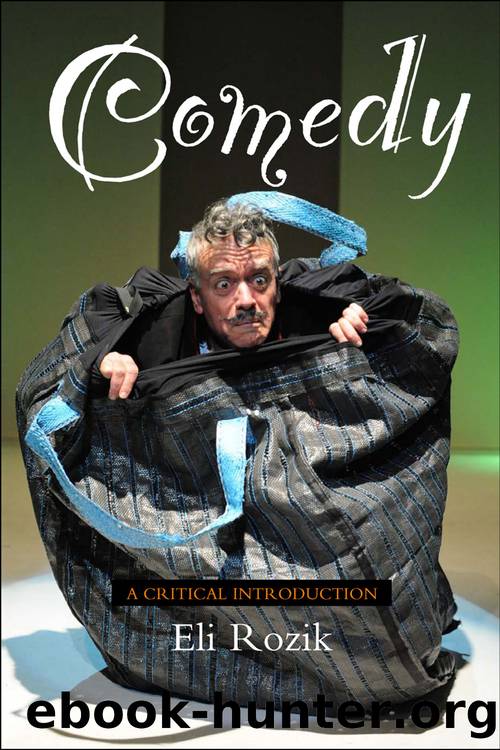Comedy A Critical Introduction by Eli Rozik

Author:Eli Rozik
Language: eng
Format: epub
Publisher: Sussex Academic Press
Published: 2021-01-02T00:00:00+00:00
Farce
Basically, there is an unbridgeable gap between the serious and the humorous moods, and gradation is found only within each mood. Similar to the relation between tragedy and melodrama, the boundaries between comedy proper and farce too are not clear-cut. Nonetheless, it is clear that both these genres operate the lighthearted mood, leading to the thesis that their differences are only a matter of degree. The following considerations are attempts to establish the nature of these boundaries.
(a) Farce is characterized by the lifting of severe inhibitions. Bentley claims that â[i]n farce we can never be in the mood to feel sorry for the victims. We are having too good a time doing the victimization. Toward both the attacker and the attacked farce is unemotional as it is unreflectiveâ (p. 298). Indeed, farce gives the impression that the suffering of the victim is enjoyable; e.g. Molièreâs George Dandin. Moreover, whereas farce âis âunfeelingââ, in comedy âfeeling is not only present but abundantâ (ibid.). Indeed, farce is quite violent, crude and highly uninhibited in lifting the audienceâs inhibitions: it touches themes, such as jealousy, adultery and cuckoldry, which both produce additional anxiety and enable powerful catharsis. This indicates that, indeed, the difference is only a matter of degree.
Bentley also contends that â[i]n farce what lies beneath the surface is pure aggression, which gets no moral justification, and asks noneâ (p. 296). However, analyses of farces indicate that it is indeed crude and violent, but not aggressive. In order to be aggressive there is a need for an extra-fictional object, as in satire. Bentley is aware that violence is shared by all fictional genres, including tragedy and melodrama, but observes that â[f]arce is perhaps even more notorious for its love of violent imagesâ (p. 219) â with the reason being that âif art did not treat violence, it could not go to the heart of thingsâ (p. 221). Does farce excel in going to the heart of things, perhaps even more than tragedy? Is tragedy not more violent?
Bentleyâs approach to farce is inspired by psychoanalysis, particularly in its thesis that laughter involves the lifting of inhibitions. It is precisely thus that farce both coerces the spectator to confront the shameful and even suppressed contents of the psyche, and potentially leads to extreme pleasure. It does so through a fictional world that disregards these inhibitions, under the safe conditions of theatreâs permissive atmosphere; i.e., of a collective experience that tacitly permits such exposure to usually inhibited and even suppressed contents of the psyche. âFarce affords an escape from living, a release from the pressures of today, a regression to the irresponsibility of childhoodâ (p. 298). The problem is that catharsis is not an escape from life, especially not to childhood, but a mechanism that enables release of the tension that is produced by merely living under normative inhibitions â thus making life possible. This principle applies also to comedy proper, despite differences in degree.
(b) The extremely uninhibited nature of farce indicates that its peculiarity is a matter of synchronic decorum.
Download
This site does not store any files on its server. We only index and link to content provided by other sites. Please contact the content providers to delete copyright contents if any and email us, we'll remove relevant links or contents immediately.
Call Me by Your Name by André Aciman(18954)
Ready Player One by Cline Ernest(12831)
How to Be a Bawse: A Guide to Conquering Life by Lilly Singh(6688)
Wiseguy by Nicholas Pileggi(4583)
The Kite Runner by Khaled Hosseini(4417)
On Writing A Memoir of the Craft by Stephen King(4206)
The Crown by Robert Lacey(4100)
Audition by Ryu Murakami(4092)
Call me by your name by Andre Aciman(4065)
Harry Potter and the Cursed Child: The Journey by Harry Potter Theatrical Productions(3955)
Gerald's Game by Stephen King(3913)
The Perils of Being Moderately Famous by Soha Ali Khan(3781)
Dialogue by Robert McKee(3576)
Dynamic Alignment Through Imagery by Eric Franklin(3483)
Apollo 8 by Jeffrey Kluger(3196)
How to be Champion: My Autobiography by Sarah Millican(3182)
Seriously... I'm Kidding by Ellen DeGeneres(3098)
Darker by E L James(3086)
History of Dance, 2E by Gayle Kassing(2997)
